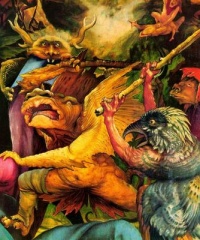Colmar
From The Art and Popular Culture Encyclopedia
|
"After reading his Three Primitives you may be tempted to visit Colmar, where hang in the museum several paintings by Mathias Grunewald, who is the chief theme of the French writer's [Huysmans] book."--Egoists: A Book of Supermen (1909) by James Huneker |
|
Related e |
|
Featured: |
Colmar is a commune in the Haut-Rhin department in Alsace in north-eastern France.
Colmar is the home town of the painter and engraver Martin Schongauer and the sculptor Frédéric Bartholdi, who designed the Statue of Liberty. The city is renowned for its well preserved old town, its numerous architectural landmarks and its museums, among which the Unterlinden Museum.
Colmar's cityscape (and neighbouring Riquewihr's) served for the design of the Japanese animated film Howl's Moving Castle. Maison Pfister can easily be spotted in the film.
Contents |
Main sights
Mostly spared from the destructions of the French Revolution and the wars of 1870–1871, 1914–1918 and 1939–1945, the cityscape of old-town Colmar is homogenous and renowned among tourists. An area that is crossed by canals of the river Lauch (which formerly served as the butcher's, tanner's and fishmonger's quarter) is now called "little Venice" (la Petite Venise).
Architectural landmarks
Colmar's secular and religious architectural landmarks reflect eight centuries of Germanic and French architecture and the adaptation of their respective stylistic language to the local customs and building materials (pink and yellow Vosges sandstone, timber framing).
Secular buildings
- Maison Adolph – 14th century (German Gothic)
- Koifhus, also known as Ancienne Douane – 1480 (German Gothic)
- Maison Pfister – 1537 (German Renaissance).
- Ancien Corps de garde – 1575 (German Renaissance)
- Maison des Chevaliers de Saint-Jean – 1608 (German Renaissance)
- Maison des Têtes – 1609 (German Renaissance)
- Poêle des laboureurs – 1626 (German Baroque)
- Ancien Hôpital – 1736–1744 (French Classicism)
- Tribunal de grande instance – 1771 (French Classicism)
- Hôtel de ville – 1790 (French Classicism)
- Cour d'Assises – 1840 (French Neoclassicism)
- Théâtre municipal – 1849 (French Neoclassicism)
- Marché couvert – 1865 (French Neo-Baroque). The city's covered market, built in stone, bricks and cast iron, still serves today.
- Préfecture – 1866 (French Neo-Baroque)
- Water tower – 1886. Oldest still preserved water tower in Alsace. Out of use since 1984.
- Gare SNCF – 1905 (German Neo-Baroque)
- Cour d'appel – 1906 (German Neo-Baroque)
Museums
- Unterlinden Museum – one of the main museums in Alsace. Displays the Isenheim Altarpiece, a large collection of medieval, Renaissance and baroque Upper-Rhenish paintings and sculptures, archaeological artefacts, design and international modern art.
- Musée Bartholdi – the birthplace of Frédéric Auguste Bartholdi shows his life and work through paintings, drawings, family objects and furniture as well as numerous plaster, metal and stone sculptures. A section of the museum is further dedicated to the local Jewish community's heritage.
See also


